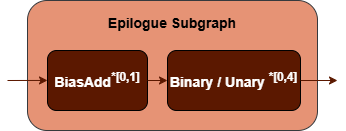ConvTranspose Fusion Patterns#
Overview#
oneDNN supports both floating-point and quantized ConvTranspose fusion patterns to optimize performance and reduce memory bandwidth requirements. This document describes the supported floating-point fusion patterns for ConvTranspose. For quantized ConvTranspose fusion patterns, refer to Quantized ConvTranspose Fusion Patterns for more details.
Pattern Structure#
oneDNN defines floating-point ConvTranspose fusion patterns as follows. The blue nodes are required when defining a ConvTranspose fusion pattern while the brown nodes are optional.

ConvTranspose Operation : Performs transposed convolution between the
srcandweightstensors. Thebiastensor is optional. See the ConvTranspose operation in the Graph API for more details.Epilogue Subgraph : Optional and can include the following operations:
BiasAdd operation.
Binary and Unary operations: refer to the Note in Fusion Patterns.
Combination Rules:

BiasAdd : If present, must be the first op in the epilogue subgraph and can only appear once.
N=20, 0 to 20 Binary or Unary operations are supported in the epilogue subgraph.
Data Types#
oneDNN supports the following combinations of data types for src, weights, bias and dst:
src |
weights |
bias |
dst |
|---|---|---|---|
f32,bf16,f16 |
f32,bf16,f16 |
f32,bf16,f16 |
f32,bf16,f16 |
The definition of the data types and support status on different CPU and GPU platforms follow the general description in the Data Types Guide.
